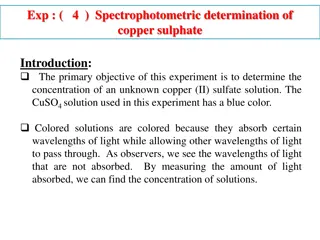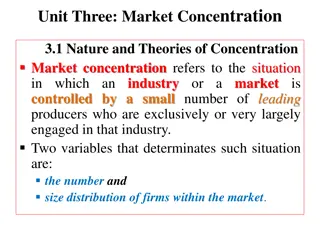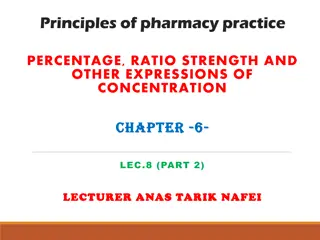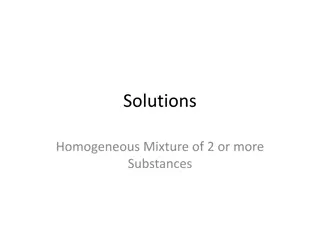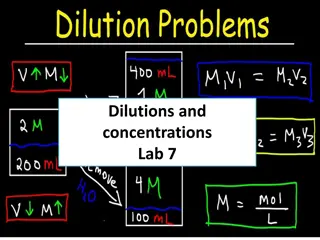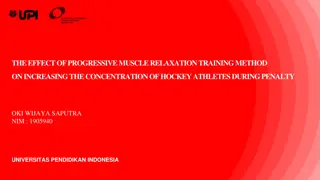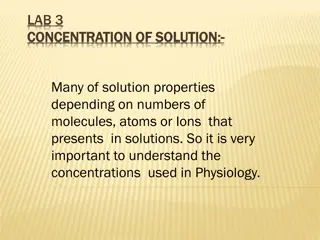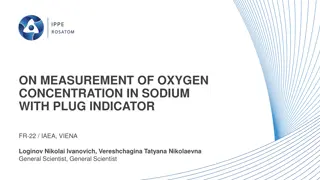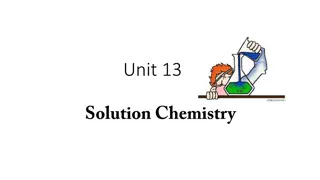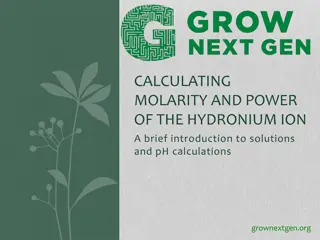Understanding Concentration in Solutions
Solutions involve the dissolution of solutes like salt or sugar in solvents such as water, resulting in different concentrations. This concentration can be expressed as moles per liter, known as molarity. By calculating the amount of substance in moles using solution volume and concentration, you can determine whether a solution is concentrated or dilute. The process involves understanding standard solutions with known concentrations and using formulas to find the required amount of solute.
Download Presentation

Please find below an Image/Link to download the presentation.
The content on the website is provided AS IS for your information and personal use only. It may not be sold, licensed, or shared on other websites without obtaining consent from the author. Download presentation by click this link. If you encounter any issues during the download, it is possible that the publisher has removed the file from their server.
E N D
Presentation Transcript
Moles and Solutions - Concentrations Learning Objectives: Calculate the amount of substance in moles, using solution volume and concentration Describe a solution s concentration using the terms concentrated and dilute. Key Words: Solution, solvent, solute, concentration, moles, volume, concentrated, dilute.
Concentration In a solution the solute (e.g. salt/sugar) dissolves in the solvent (usually water). For example in a solution of table salt the salt is the solute and water is the solvent. The Resulting liquid is a solution of NaCl in water. We can measure how much solute there is per unit volume of solvent to give a value for concentration
If we dissolve 158g of KMnO4 in 1Litre of water we would make a solution of concentration 1mol L-1 158g of KMnO4 Image:Potassium-permanganate-sample.jpg 1 litre (dm3) of water Resulting solution contains 1 mole of KMnO3 per dm3 of water This is known as a 1 molar solution 1M
If we take 250 cm3 if the solution we made how many moles of KMnO3 are there in that sample? 250 cm3 of a 1M solution 1 dm3 of a 1M solution Contains 0.25 moles Resulting solution contains 1 mole of KMnO3 per dm3 of water Therefore 39.5 g of KMnO3
How to Calculate Concentration If you know the concentration of a solution you can find the amount of substance in any volume of that solution. n = c x V(in dm3) or c = _n_ v If the volume you are given is in cm3 you will need to divide by 1000 to convert it to Litres or dm3. n = no. of moles c = concentration in mol dm-3 V = volume in dm3 How can you turn this into a formula triangle?
Standard Solutions A standard solutionhas a known concentration. To do this Consider the volume of solution needed Work out the amount, in mol, of solute needed Convert this amount into mass, in g, so you know how much to weigh out. For Example: Find the mass of potassium hydroxide required to prepare 250 cm3 of a 0.2000 mol dm-3 solution
Concentrated or Dilute Solutions The terms concentrated and dilute describe the relative amount of solute in a solution. Concentrated a lot of solute per dm3 Dilute a small amount of solute per dm3 Normal lab bench solutions of acids have a concentration 1 or 2 mol dm-3 - these are dilute solutions. Concentratedacids are solutions of above 10 mol dm-3
Questions 1) Find the amount, in moles, of solute dissolved in the following solutions; a) 4 dm3 of a 2 mol dm-3 solution b) 20.0 cm3 of a 0.150 mol dm-3 solution c) 24.35 cm3 of a 0.125 mol dm-3 solution 2) Find the concentration, in mol dm-3 of the following solutions a) 6 moles dissolved in 2 dm3 of water b) 0.5000 moles dissolved in 250 cm3 of solution c) 8.75 x 10 -3 moles in 50.0 cm3 of solution. 3) Find the mass concentration, in g dm-3, in the following (a) 0.42 moles of HNO3 (b) 0.500 moles of HCl dissolved in 4 dm3 of solution (c) 3.56 x 10 -3 moles of H2SO4 dissolved in 25 cm3 of solution in 250 cm3 of solution



